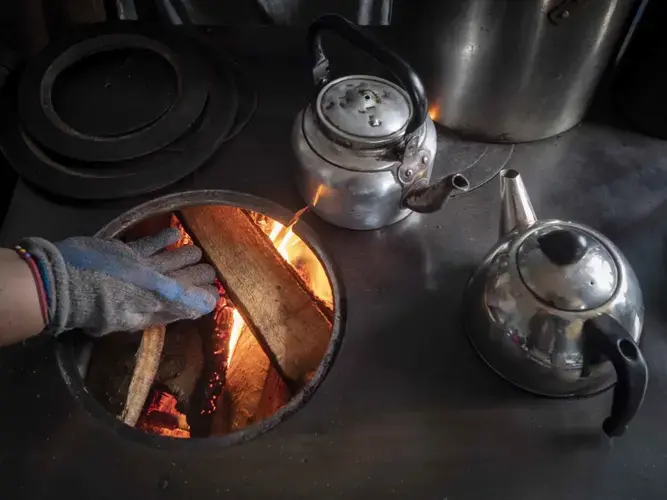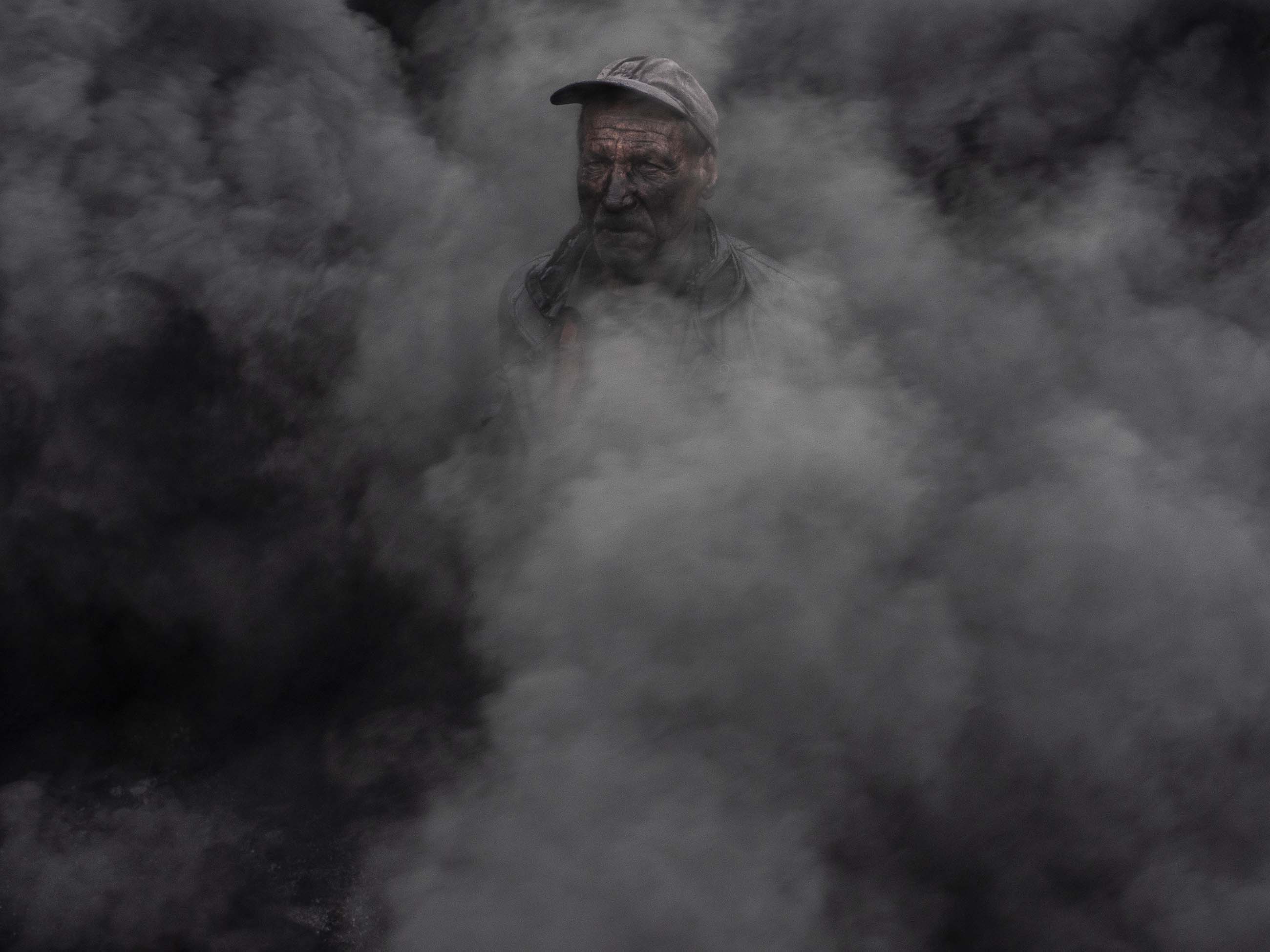
ON A MIDWINTER Saturday just before dusk, Angelica Calderón, a 22-year-old mother of two, sat in the waiting room of the public hospital in Coyhaique. Her youngest child, just two months old, was suffering from an aggressive respiratory infection that kept him in intensive care for more than a week, and like so many other mothers in this crowded facility, her face was etched with worry. “All of this must be because of pollution,” she lamented.

Coyhaique, a city of roughly 60,000 people in southern Chile, is the capital of the Southern Patagonian Aysén Region, and for years it was promoted as a pristine natural reserve — a gateway to Patagonia surrounded by mountains, streams, and fresh air. Today, the air in Coyhaique is widely considered to be the most polluted in South America. On certain days and at some specific hours, it can be among the most polluted cities in the world.
An analysis conducted by Patricio Pérez at the University of Santiago (USACH) in May of 2016 established that Coyhaique often sees hourly concentrations of PM 2.5 — microscopic and deadly particulate pollution 30 times smaller than the width of a human hair — higher than Beijing, although the Chinese capital has higher annual concentrations.
Still, the impacts are real, and nobody expected this from tranquil Coyhaique. When officials first considered measuring pollution here, they thought of using it as a “control city,” said Pedro Astudillo, a doctor based in Santiago who specializes in respiratory diseases and who worked for many years on public health issues for the Chilean Health Ministry, to show how this supposedly clean Patagonian city compared to cities like Santiago.
As it stands, Coyhaique sees annual average PM2.5 concentrations of about 64 micrograms per cubic meter, well above global standards considered safe. At certain times of the year, levels can double, or even triple. And like the nation’s capital, Santiago, which also sees dangerous levels of air pollution, geography is part of its fate. Situated in natural basins surrounded by mountains, atmospheric inversions during the winter months conspire to keep smog and other air pollution pressed close to the ground. But where the noxious air in Santiago is attributable to a variety of factors, traffic and industry among them, the primary culprit in Coyhaique is simple: wood heating.
Located in the southernmost reaches of the globe, 1,200 miles from the Antarctic, temperatures in the region can drop below 0 degrees Fahrenheit during the winter, and wood — often wet and green, but also plentiful and less expensive than other options — is used in 96 percent of the homes here, according to official figures.





EFFORTS TO CURB wood use have run up against both economic and cultural resistance, but the public health impacts are hard to ignore. “The most serious problem here is pollution and how that affects public health, children, and elderly people,” said Congressman Miguel Angel Calisto, one of the politicians campaigning to address the issue. “Last year, we had several dozen children transferred to [hospitals] in other Chilean regions, mostly due to bronchopulmonary and respiratory diseases.”
Calisto’s own child was among them. “I worked hard to get a plane-ambulance to be able to transfer kids, because some of them died and several ended up with long-term physical damage.”
The pollution is often inescapable, swirling in clouds that hang heavy over the valley, and hovering in the air indoors, too — an exposure pathway that public health authorities are increasingly recognizing as a potent killer. In their most recent State of Global Air analysis, the Institute for Health Metrics and Evaluation at the University of Washington in Seattle and the research nonprofit Health Effects Institute in Boston estimated that exposure to household air pollution was responsible for as many as 2.6 million deaths worldwide in 2016 — the eighth highest risk factor for early death globally.
In Chile, the impacts are particularly acute. The United Nations Environment Program estimates that air pollution costs the Chilean health sector at least $670 million annually. This is associated with as many as 127,000 visits to emergency rooms and clinics, and more than 4,000 premature deaths annually, according to the U.N.
Indeed, respiratory infections in children — highly correlated with PM2.5 exposure — can often seem epidemic in Coyhaique. In 2017, an aggressive winter outbreak sent hundreds of children to regional hospitals, often overwhelming resources already lacking in specialists and equipment. “We have many children with long-lasting damage from Coyhaique’s pollution” said Iván Lemus, who heads up the pediatric unit of Coyhaique Regional Hospital.
“We have seen this clearly and empirically,” he added. Lemus estimated that 80 percent of admissions to the pediatric emergency unit during the winter months — and a little more than half annually — are related to respiratory diseases.
Several mothers in Coyhaique have been organizing public demonstrations to raise awareness of air pollution problems in the city, and to force politicians to take action. Pamela Galindo, whose daughter Natalie has chronic asthma, is among them. Like so many other children here, Natalie had her first asthma episode when she was 4 years old. Now 10, she wears a mask at all times outdoors, and must inhale steroids twice a day to control asthma attacks.
Her mother is among the small but growing number of local residents who have transitioned away from wood. The home’s heating and cooking systems were upgraded from wet wood to a combination of wood pellet, paraffin, and gas. The family has also enrolled in a pioneer governmental test program that provides them with an indoor pollution monitor.
Such efforts at reform are slow but ongoing. Encouraging residents to avoid black market, uncertified green wood supplies, which produce substantially more particulate pollution than certified dry wood is one such tactic. And a variety of pilot projects are exploring other ways to bring alternative heating and cooking fuels to the wood-dependent community.
Still, with a growing population, progress is slow, and both outdoor and indoor particulate pollution can often be staggeringly high. (Undark measured PM2.5 levels at more than 300 micrograms per cubic meter of air inside some residents’ homes — multiple times beyond what public health experts consider safe.)
MORE THAN 1,000 miles to the north, Santiago has long battled its own air pollution problems. The capital city — home to 5.6 million people — has a similar geographic profile, and two decades ago, air pollution was endemic. The attending health problems associated with pollution, particularly in many of Chile’s central and southern cities, prompted the federal government to launch an ambitious program to replace 200,000 wood-burning stoves with cleaner-burning paraffin or wood-pellet heaters, though the status of this program could not be confirmed with officials. A 2014 vehicle emissions tax also targeted emissions of carbon dioxide and nitrogen oxide, and incentives were put in place to encourage import of lower-pollution vehicles that comply with European clean air standards.
According to Chilean environmental officials, the moves have helped nudge emissions of particulate matter down in many urban areas. As a result, the Chilean Ministry of the Environment reported a reduction in “severe air pollution episodes,” in major cities of the center-south region by as much as 45 percent from 2016 to 2017. Pérez of the University of Santiago cautioned, however, that looking at one year in isolation may be misleading, as more favorable weather conditions, rather than policies aimed at addressing pollution, “would have made a very drastic reduction in episodes.” (Such episodes are also measured against Chile’s maximum daily standard of 50 micrograms of PM2.5 per cubic meter, compared to the WHO’s standard of 25.)
FROM THE CAPITAL TO COYHAIQUE An aerial survey of the pollution problems facing Santiago and Coyhaique.
Air Pollution in Chile from Undark Magazine on Vimeo.
Coyhaique sees annual average PM2.5 concentrations of about 64 micrograms per cubic meter, well above global standards considered safe. At certain times of the year, levels can double, or even triple. And like the nation's capital, Santiago, which also sees dangerous levels of air pollution, geography is part of its fate.
Still, in its efforts to combat pollution, Santiago has also joined the Breathe Life Campaign, a joint effort of the World Health Organization and the United Nations aimed at uniting regions and cities to share best practices for curbing air pollution and to provide more widespread monitoring of air quality. Among the initiatives implemented by the city is a coordinated response protocol for dangerous “environmental episodes” — days when air quality is projected to be at unhealthy levels. The episodes trigger not just public alerts, but can also involve mandatory driving restrictions, the temporary shutdown of major industrial polluters, and other actions aimed at curbing pollution. A 2014 study suggested that the system has been able to reduce concentrations of particulate matter in the Santiago Metropolitan Region “by approximately 20 percent on the day of implementation, with effects persisting into subsequent days.”
The capital region, of course, still struggles with ambient PM2.5 levels that are often above what global health officials consider safe. Periods of smog in Santiago increased the number of high pollution days to 40 this year, compared with 29 in 2017. Other cities have fared even worse, with Talca in Chile’s central Maule region experiencing more than twice the number of “critical episodes” in 2018 compared to last year. And this year’s comparatively harsh winter has only helped to increase reliance on wood burning, according to Pablo Sepúlveda, regional ministerial secretariat for the environment of the Maule region. “The intense frosts,” he was quoted as saying by La Tercera newspaper, “have made it harder to comply with restrictive measures by citizens.”
AIR POLLUTION BY THE NUMBERS The capital city of Santiago continues to struggle with dangerous levels of pollution — particularly during the winter months. Click here for the interactive graph composed of data from early 2017 to July 2018.
SUCH REALITIES are familiar to outposts like Coyhaique — and many anti-pollution activists have argued that Chile’s government is failing to both acknowledge and act upon the serious pollution issues facing many regions outside the capital. These critics include Santiago-based lawmaker and doctor Guido Girardi. Well-known internationally for his public health initiatives, Girardi is president of the Health Commission of the Chilean Senate. He calls the persistently high PM2.5 levels — particularly in Chile’s southern communities — an outrage.
When daily PM2.5 levels in Coyhaique register at 700 micrograms per cubic meter, “that is clearly a health emergency,” Girardi said. “Those levels are reached not once but in a continuous and sustained fashion.
“In Santiago, there is panic when levels reach 200,” he added, calling the situation in the south “ethically and socially” unacceptable. “I am convinced that air pollution is one of the worst problems that we have in Chile.”
But expressions of resignation on that front — and even helplessness — are not hard to find in Coyhaique. Back in the public hospital, Angelica Calderón stared blankly as she waited for news on her son. “All of this must be due to the same thing: pollution,” she said, “because the air is really bad.” While she is supposed to ventilate the house, Calderón noted that smoke then comes in from outside, suggesting that protecting the children of Coyhaique from air pollution had become a Sisyphean task.
“As much as you look after them it doesn’t matter,” she said. “At the end, they get sick just the same.”
Patricia Luna is a Santiago-based science journalist and regular freelance correspondent for the Associated Press, Agence France-Presse (AFP), the BBC World Service, and El Pais, among other outlets.

Education Resource
Meet the Journalist: Larry C. Price
Award-winning documentary photographer and multimedia journalist Larry C. Price traveled the world...



















